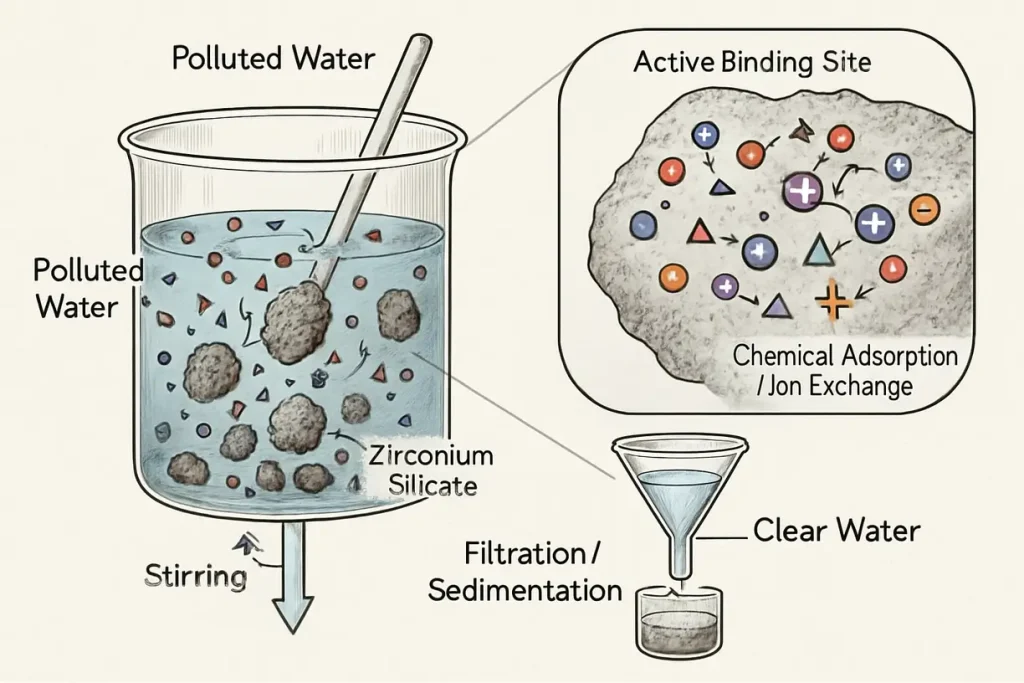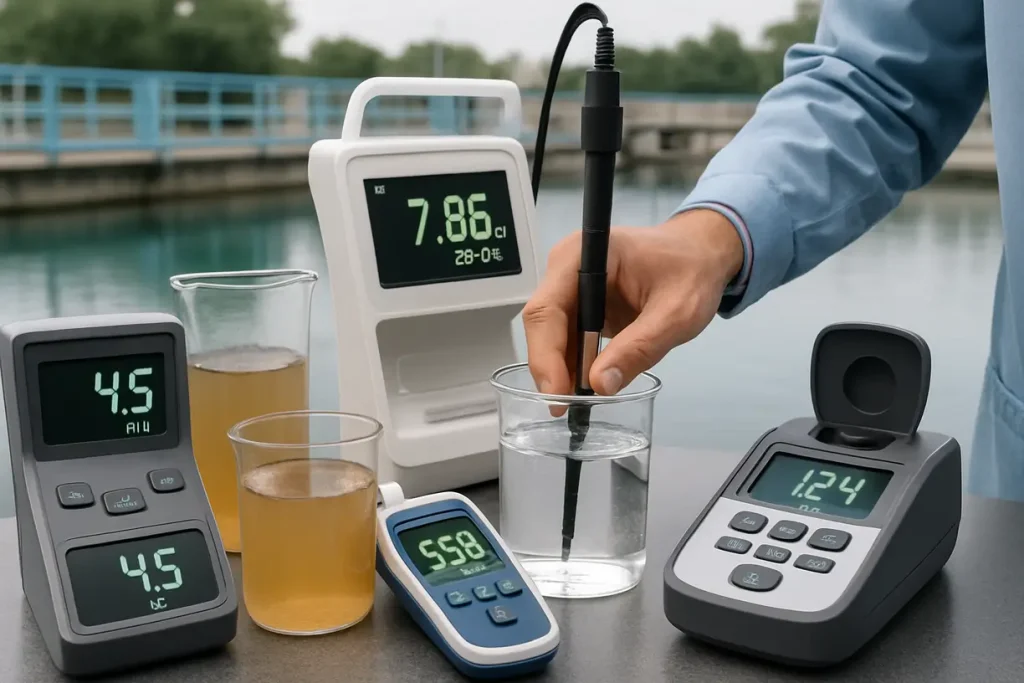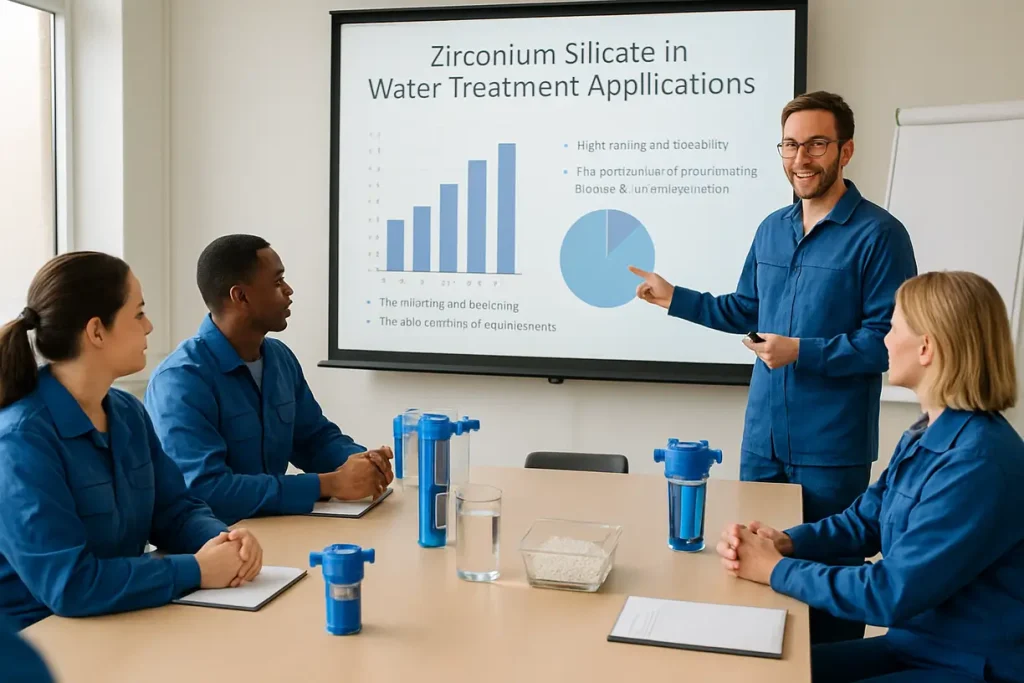In the quest for effective water purification, decision-makers often grapple with finding reliable and efficient materials. The challenge lies in selecting a solution that not only supports environmental goals but also meets stringent regulatory requirements. This article explores the role of zirconium silicate in water purification technologies, offering insights into its properties and applications. By understanding how this material can enhance water treatment processes, businesses can make informed choices that lead to improved water quality and operational efficiency. Drawing on industry expertise and case studies, we aim to provide valuable knowledge for professionals looking to optimize their water treatment strategies.
How Does Zirconium Silicate Enhance Water Filtering?
Zirconium silicate offers unique advantages in water filtration. Its chemical properties allow it to effectively remove contaminants, providing a solid option for various applications. One key characteristic of this material is its high adsorption capacity. This means it can trap various impurities such as heavy metals and organic contaminants more efficiently than many traditional materials.

The image illustrates the process by which zirconium silicate adsorbs contaminants from water, showcasing its filtration capability.
The mechanisms at play are intriguing. Zirconium silicate interacts with water through ion exchange and surface adsorption, which contribute to its effectiveness. This results in cleaner water with fewer harmful substances, crucial for industries reliant on pure water. This interaction also reduces the concentration of detrimental pathogens, thus playing a vital role in safeguarding public health.
But that’s just the beginning: the effectiveness of zirconium silicate is also influenced by factors such as pH levels, temperature, and the presence of other chemicals in the water. This adaptability makes it suitable for various settings, from municipal water treatment plants to specialized industrial applications. Many businesses have successfully integrated this material into their systems, highlighting its practical benefits and effectiveness.
To give a clearer picture, let’s look at a quick comparison of zirconium silicate against several other filtration media and their applications:
| Filter Material | Adsorption Capacity | Cost-Effectiveness | Typical Applications |
|---|---|---|---|
| Commercial Activated Carbon | Moderate | Moderate | Municipal, Residential |
| Sand Filters | Low | Low | Simple applications |
| Zirconium Silicate | High | High (Long-term savings) | Industrial, Advanced Treatment |
Overall, the use of this advanced material enhances water filtering through its unique properties and mechanisms, making it a compelling choice for water treatment needs across various sectors.
What Are the Key Applications of Zirconium Silicate?
Zirconium silicate has a broad range of applications in water purification. One of its primary uses is in industrial waste treatment. Industries like mining and manufacturing produce contaminated water that requires efficient purification. This material can significantly reduce heavy metal levels, such as lead and cadmium, thereby ensuring compliance with stringent regulatory standards.
Municipal water treatment facilities also benefit from this versatile substance. As communities strive to provide safe drinking water, the addition of zirconium silicate has proven effective in meeting health standards. By lowering pollutant levels, municipalities can enhance public health and safety, positioning themselves as responsible stewards of community well-being.
In residential water systems, homeowners increasingly seek ways to improve water quality right at their taps. Filter systems incorporating zirconium silicate help in removing impurities, making drinking water safer. This capability resonates with consumers who are more health-conscious and aware of water contaminants than ever before.
You might be intrigued by this: the unique properties of zirconium silicate extend beyond simple filtration. Here are some specific applications where this material shines:
- Heavy Metal Removal: Effectively captures and thermally stabilizes hazardous materials.
- Fluoride Reduction: Popular in areas where high fluoride levels are a concern.
- Color and Odor Removal: Improves the sensory attributes of raw water, enhancing its drinkability.
Case studies show many have upgraded their existing systems with this material; the results reflect an improvement in water quality standards and customer satisfaction.
| Application Area | Benefits | Examples |
|---|---|---|
| Industrial Waste Treatment | Reduces heavy metals, regulatory compliance | Mining, Manufacturing |
| Municipal Water Treatment | Meets health standards, enhances safety | Drinking water, Public utilities |
| Residential Filtration | Improves household water quality | Home water filters, Point-of-use systems |
Each application showcases zirconium silicate’s versatility and effectiveness, making it an essential material in modern water purification technologies.
Why Choose Zirconium Silicate for Purification Technologies?
Choosing this advanced filtration material offers distinctive advantages. One of its notable strengths is the efficiency of pollutant removal. Research indicates that zirconium silicate consistently outperforms many conventional filtration materials, making it a preferred choice for industries seeking cost-effective solutions without compromising on quality.
Long-term cost savings are another compelling reason to consider this material. While the initial investment may appear higher than some alternatives, the reduction in replacement frequency and maintenance costs leads to substantial savings over time. Organizations that have adopted zirconium silicate typically report fewer filter changes and lower operational costs, further strengthening their bottom line.
But there’s more: the environmental impact of zirconium silicate is a significant factor as well. As industries pivot toward sustainability, using a material that provides effective purification while minimizing environmental footprints stands out as a critical consideration. It aligns with the growing trend of corporate responsibility, allowing companies to meet environmental regulations more easily.
Zirconium silicate is compliant with various national and international regulations. This compliance supports businesses in maintaining adherence to laws regarding potable water quality, thus avoiding costly fines and penalties. Engaging with environmental agencies further solidifies this material’s standing as a reliable choice.
| Benefit | Description | Impact on Business |
|---|---|---|
| Enhanced Pollutant Removal | Greater efficiency in cleaning impurities | Improved water quality and compliance |
| Long-Term Cost Savings | Lower replacement and maintenance frequency | Better budget allocation |
| Environmentally Friendly | Aligns with sustainability goals | Positive corporate image |
| Regulatory Compliance | Meets various health and safety standards | Avoidance of fines |
Each of these compelling advantages reinforces why zirconium silicate is an ideal choice for companies focused on both quality and sustainability in their water purification strategies.
How Does Zirconium Silicate Affect Water Quality?
The impact of zirconium silicate on water quality is profound and multi-dimensional. Its ability to remove contaminants leads to cleaner, safer drinking water while also reducing the risk of waterborne diseases. Tests have shown that utilizing zirconium silicate significantly decreases the levels of harmful substances like lead, mercury, and other heavy metals.
This advanced material also positively affects the sensory attributes of water. By addressing issues such as unpleasant taste, odor, and cloudiness, zirconium silicate enhances the overall drinking experience. This improvement can benefit businesses that rely on customer satisfaction, particularly those in the food and beverage industry.
Here are some key areas where zirconium silicate improves water quality:
- Taste Improvement: Reduces metallic and chemical flavors.
- Color Clarity: Restores water clarity, making it visually appealing.
- Microbial Reduction: Aids in inhibiting bacterial growth, promoting a safer product.
Monitoring water quality post-treatment is vital to validate the efficacy of zirconium silicate. Operators can conduct tests for parameters such as pH, turbidity, and specific contaminants to ensure effective and safe water purification.

An image showcasing water quality testing equipment, vital for ensuring treatment effectiveness.
Here’s the bottom line: incorporating zirconium silicate not only polishes water quality but also addresses public health concerns effectively. Businesses can confidently assure consumers that the water they are providing meets the highest quality standards by utilizing this state-of-the-art material.
| Water Quality Parameter | Before Treatment | After Treatment | Improvement |
|---|---|---|---|
| Heavy Metals (Lead) | 0.15 mg/L | 0.01 mg/L | 93% reduction |
| pH Level | 6.5 | 7.0 | Ideal range |
| Turbidity (NTU) | 10 | 1 | Significant reduction |
Thus, the influence of zirconium silicate on water quality is critical, proving its value in enhancing both safety and sensory attributes.
What Are the Challenges with Using Zirconium Silicate?
While zirconium silicate presents numerous benefits, some challenges also exist. One limitation arises in specific water conditions. Highly acidic or alkaline waters may reduce the material’s efficiency, and adjustments may be needed to achieve optimal performance. Testing before implementation is crucial to identify any potential compatibility issues.
Technical hurdles can arise during implementation. Depending on existing systems, integrating zirconium silicate into established processes might require additional modifications. Training staff to manage these changes is essential for successful application. Ensuring that team members understand both the features and functions of this material is key to unlocking its full potential.
You may have questions about overcoming these challenges: organizations should be prepared to conduct thorough assessments and pilot tests before full-scale integration. This proactive approach helps minimize risks while setting the stage for smooth transitions.
Common misconceptions about zirconium silicate include overestimating its capabilities. Some users may assume it can remove all contaminants, which is not always the case. While it is highly effective, zirconium silicate works best in conjunction with other filtration methods to provide comprehensive water treatment.
| Challenge | Description | Solutions |
|---|---|---|
| Compatibility Issues | May struggle in extreme pH conditions | Pre-treatment adjustments |
| Technical Implementation | Possible need for system modifications | Staff training and pilot programs |
| Misconceptions | Assumption of complete contaminant removal | Education on filtration capabilities |
By addressing these challenges proactively, businesses can ensure successful integration and fully benefit from zirconium silicate’s strengths.
How Do Industry Standards Affect Zirconium Silicate Use?
Industry standards play a critical role in the utilization of zirconium silicate for water purification. Adherence to national and international regulations ensures that treatment processes are safe and effective. Organizations must understand these guidelines to select appropriate materials and comply with health and safety requirements.
For instance, regulatory agencies such as the Environmental Protection Agency (EPA) provide frameworks for acceptable contaminant levels. These standards directly impact how zirconium silicate is utilized in various applications, particularly in municipal and industrial water treatment. Organizations must keep abreast of changes in these regulations to maintain compliance and operate efficiently.
Selecting zirconium silicate that meets these regulations fosters accountability and reliability. Businesses demonstrate their commitment to public health and environmental stewardship, thereby enhancing their reputation in the market. Engaging with industry associations can provide additional resources and insights regarding evolving standards.
What to keep in mind: staying updated on regulatory changes allows organizations to adapt their processes accordingly. Proactive compliance ensures operational integrity and builds consumer trust, which is paramount in today’s market.
| Regulation Body | Relevant Standards | Impact on Usage |
|---|---|---|
| EPA | Safe Drinking Water Act | Sets contaminant limits |
| WHO | International drinking water guidelines | Provides acceptable water qualities |
| Local Health Authorities | Specific regional requirements | Tailors practices to local needs |
Organizations can leverage their compliance as a competitive advantage in the marketplace, thereby ensuring their processes are aligned with public expectations and legal mandates.
What Innovations Are Present in Zirconium Silicate Technology?
Ongoing innovations in zirconium silicate technology underscore its importance in water purification. New research focuses on enhancing its effectiveness and expanding its applications. For example, scientists are developing composite materials that combine zirconium silicate with other filtration media to improve overall performance. These innovations can lead to systems that are not only more efficient but also better suited to meet diverse water quality challenges.
Emerging advancements include novel methods for manufacturing zirconium silicate products. Techniques such as nanotechnology can refine its properties, therefore improving adsorption capabilities, thus increasing its applicability across various sectors. These advancements address both capacity and efficiency, creating a more effective water treatment system.
Case studies showcase these innovations in action. For instance, a wastewater treatment plant recently adopted an advanced zirconium silicate system that reduced contaminant levels by over 90%. This remarkable achievement led to notable improvements in water clarity and quality, reinforcing the importance of continual advancements.
You might find this surprising: Opportunities for collaboration between research and industry can lead to breakthrough applications. Engaging with academic institutions or technology partners enhances access to cutting-edge developments and fosters innovation.
| Innovation Area | Description | Example Impact |
|---|---|---|
| Composite Filtration Materials | Blends zirconium silicate with other media | Improved filtration efficiencies |
| Advanced Manufacturing Techniques | Cost-reducing production methods | Expanded market reach |
| Research Collaborations | Partnerships with academic institutions | Accelerated access to innovations |
The drive for innovation keeps zirconium silicate relevant and effective in evolving water treatment scenarios.
How Can Businesses Implement Zirconium Silicate in Their Systems?
Implementing this advanced material into existing water treatment systems requires careful planning. The first step involves assessing the current system’s compatibility. Understanding how zirconium silicate will fit within existing processes is crucial for a smooth transition. Companies should evaluate their current filtration methods to identify areas where this material can provide the most significant benefits.
Selecting quality suppliers is equally important. Businesses should seek out reputable companies known for their reliable zirconium silicate products. Engaging with trusted suppliers ensures consistent quality and allows organizations to create strategic partnerships for ongoing support.
Moreover, training the staff is a vital component in the implementation phase. Employees must understand the properties of zirconium silicate and how it will function within the filtration process. Providing adequate training resources facilitates smooth operational adjustments and fosters confidence among team members, thereby promoting a culture of excellence.

Staff training sessions to educate teams on the effective use of zirconium silicate in water treatment procedures.
Here’s the deal: starting with pilot projects can mitigate risks. Testing zirconium silicate in smaller applications helps uncover potential challenges and optimize the approach before broader implementation. This phased approach allows for learning and adjustment, making it easier to scale operations.
| Implementation Steps | Description | Importance |
|---|---|---|
| System Compatibility Assessment | Evaluating existing structures and processes | Ensures fit and effectiveness |
| Supplier Selection | Choosing reputable sources for zirconium silicate | Guarantees quality |
| Staff Training | Educating employees on material usage and performance | Enhances operational confidence |
Each step lays the groundwork for a successful integration of zirconium silicate in water purification systems.
What Is the Future of Zirconium Silicate in Water Treatment?
Looking ahead, the future of zirconium silicate in water treatment appears promising. Predictions suggest increased demand for efficient purification solutions will continue to drive innovation within the sector. As industries become more environmentally conscious, the need for sustainable materials will remain paramount.
Additionally, advancements in technology will facilitate broader applications for this material, from improving existing systems to developing new methods. This evolution reflects a growing commitment to enhancing water quality on a global scale. Moving forward, collaboration between industries and research institutions is essential for fostering innovations that can address complex water treatment challenges.
Case studies project a significant upward trend in zirconium silicate integration, particularly in regions facing water scarcity. As companies prioritize access to clean water, the strategic application of this advanced material offers a viable solution.
But there’s more: ongoing research will likely reveal new benefits and applications, positioning zirconium silicate as a cornerstone in future water treatment technologies. As businesses align their needs with innovative developments, collaborations can pave the way for enhanced capabilities in water purification.
| Future Trends | Description | Potential Developments |
|---|---|---|
| Increased Demand | Growing focus on efficient purification systems | Expanded market opportunities |
| Technological Advancements | Innovations in application techniques | Improved system performance |
| Global Water Accessibility | Initiatives targeting clean water access | Heightened reliance on zirconium silicate |
Each of these trends indicates a solid and progressive future for zirconium silicate in addressing global water challenges.
Conclusion
In summary, zirconium silicate plays a vital role in enhancing water purification technologies. This material offers unparalleled pollutant removal, long-term cost savings, and environmental benefits that position it favorably for businesses looking to optimize water treatment processes. By partnering with Global Industry, organizations can access quality zirconium silicate solutions tailored to their specific needs. Take the next step in your water purification journey; reach out to us today for assistance and to access invaluable resources that foster superior water treatment outcomes.
FAQ Section
Q1: What makes zirconium silicate effective for water purification?
Zirconium silicate’s effectiveness lies in its high adsorption capacity, which allows it to trap a range of contaminants, including heavy metals and organic compounds. Its unique chemical structure facilitates strong interactions with impurities, leading to enhanced water quality.
Q2: Are there alternatives to zirconium silicate in water treatment?
Certainly! Alternatives include activated carbon, which is widely used for its ability to remove odors and tastes, and various membrane technologies, such as reverse osmosis. Each option has its strengths and is chosen based on specific contaminants and treatment goals.
Q3: How do you test water quality after purification?
Water quality is typically assessed through various tests, including measuring pH, turbidity, and levels of contaminants. Common methods include using test strips, laboratory analysis, and field meters. Consistent monitoring ensures that purification systems are performing effectively.
Q4: What should companies consider before switching to zirconium silicate?
Before making the switch, companies should evaluate the compatibility of this material with their existing filtration systems. Additionally, it’s important to consider regulatory compliance, as well as the overall cost analysis, including initial investment and long-term maintenance.
Q5: Can zirconium silicate remove biological contaminants?
While this material primarily excels at removing chemical contaminants, it can also reduce certain biological contaminants under specific conditions. Its efficiency in dealing with microbes can be enhanced when used alongside complementary filtration methods tailored for that purpose.
